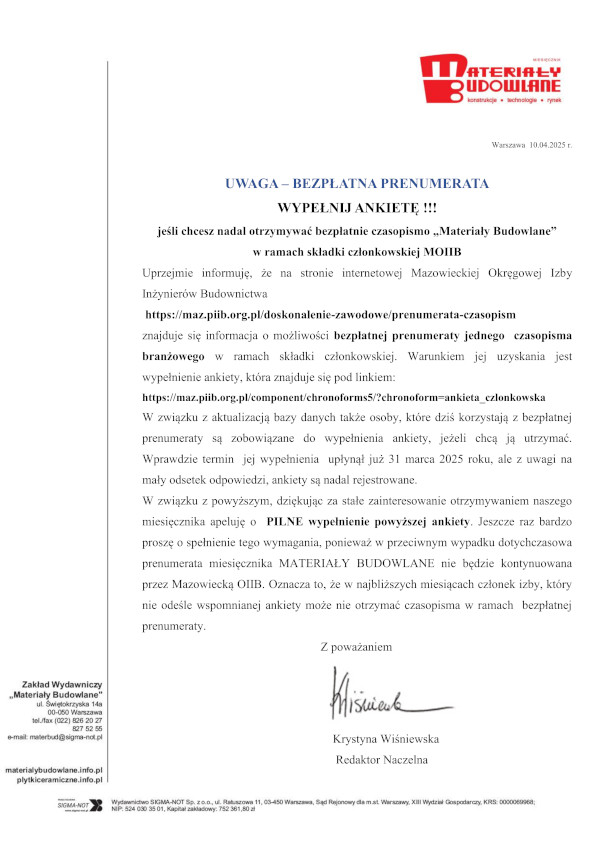Open Access (Artykuł w pliku PDF)
Effect of the composition of new generation concrete mixtures on their carbon footprint
dr inż. Daniel Wałach, AGH w Krakowie, Wydział Inżynierii Lądowej i Gospodarki Zasobami
ORCID: 0000-0002-5124-0333
Adres do korespondencji: Ten adres pocztowy jest chroniony przed spamowaniem. Aby go zobaczyć, konieczne jest włączenie w przeglądarce obsługi JavaScript.
DOI: 10.15199/33.2023.06.07
Oryginalny artykuł naukowy
Streszczenie. W artykule przedstawiono wyniki analizy, która miała na celu zbadanie wpływu różnych składów mieszanek betonowych o zbliżonych cechach mechanicznych na ich ślad węglowy na etapie produkcji. Wyniki odniesiono do ekwiwalentu dwutlenku węgla na jednostkę funkcjonalną produktu (CO2e) oraz porównano z betonami zwykłymi. Przeprowadzona analiza wykazała, że największy wpływ na wielkość śladu węglowego ma rodzaj i ilość cementu. Skład mieszanek betonowych nowej generacji może mieć istotny wpływ na ich ślad węglowy, a wysiłki zmierzające do zmniejszenia śladu węglowego przez zastosowanie alternatywnych materiałów i zmniejszanie zawartości cementu mogą przyczynić się do bardziej zrównoważonego i przyjaznego środowisku przemysłu budowlanego.
Słowa kluczowe: ślad węglowy; LCA materiałów budowlanych; zrównoważone budownictwo; dekarbonizacja.
Abstract. The paper presents the results of an analysis aimed at investigating the impact of significantly different compositions of concrete mixes with similar mechanical characteristics on their carbon footprint during production. The results were compared to the equivalent amount of carbon dioxide per functional unit of the product (CO2e) and compared to ordinary concretes. The analysis showed that the type and amount of cement have the greatest impact on the carbon footprint. The composition of new generation concrete mixes can have a significant impact on their carbon footprint, and efforts to reduce the carbon footprint of concrete by using alternative materials and reducing cement content can contribute to amore sustainable and environmentally friendly construction industry.
Keywords: carbon footprint; LCA of building materials; sustainable construction; decarbonization.
Literatura
[1] Spišáková M, Mésároš P, Mandičák T. Construction waste audit in the framework of sustainable wastemanagement in construction projects – case study. Buildings. 2021. DOI: 10.3390/buildings11020061.
[2] Jaskowska-Lemanska J. Impurities of recycled concrete aggregate-types, origin and influence on the concrete strength parameters. IOPConf. Ser.Mater. Sci. Eng. 2019. DOI: 10.1088/1757-899X/603/4/042056.
[3] Sztubecka M, Skiba M, Mrówczynska M, Bazan-Krzywoszanska A. An innovative decision support system to improve the energy efficiency of buildings in urban areas. Remote Sens. 2020. DOI: 10.3390/rs12020259.
[4] Skiba M et al. Probability estimation of the city’s energy efficiency improvement as a result of using the phase change materials in heating networks. Energy. 2021. DOI:10.1016/j.energy.2021.120549.
[5] Wałach D. Analysis of factors affecting the environmental impact of concrete structures. Sustainability. 2021. DOI: 10.3390/su13010204.
[6] Zima K, Przesmycka A. Koncepcja zintegrowanej analizy kosztów i generowanego śladu węglowego w cyklu życia budynku. Przegląd Budowlany. 2021; 10: 42 – 48.
[7] Sizirici B, Fseha Y, Cho CS, Yildiz I, Byon YJ. A review of carbon footprint reduction in construction industry, from design to operation. Materials (Basel). 2021. DOI: 10.3390/ma14206094.
[8] Mathur VS, Farouq MM, Labaran YH. The carbon footprint of construction industry: A review of direct and indirect emission. J. Sustain. Constr. Mater. Technol. 2021. DOI: 10.29187/jscmt.2021.66.
[9] Garbacz A, Urbańska P. Ślad węglowy betonu. BTA. 2021; 4: 56 – 61.
[10] European Commission. The European Green Deal. Eur. Comm. 2019. DOI: 10.1017/CBO9781107415324.004.
[11] European Commission. Fit for 55: Delivering the EU’s 2030 Climate Target on the way to climate neutrality. COM(2021) 550 Final, p. 15, 2021, [Online]. Available: https://eur-lex.europa.eu/legal-content/EN/TXT/? uri=CELEX: 52021DC0550.
[12] Polski Komitet Normalizacyjny, PN-EN 15643:2021 Zrównoważenie obiektów budowlanych. Struktura oceny budynków i obiektów inżynieryjnych. 2023.
[13] Wałach D. Economic and environmental assessment of new generation concretes. IOP Conf. Ser. Mater. Sci. Eng. 2020. DOI: 10.1088/1757899X/960/4/042013.
[14] Ali B, Yilmaz E, Sohail Jameel M, Haroon W, Alyousef R. Consolidated effect of fiber-reinforcement and concrete strength class on mechanical performance, economy and footprint of concrete for pavement use. J. King Saud Univ. – Eng. Sci. 2021. DOI: 10.1016/j. jksues. 2021.09.005.
[15] Lee M, Mata-Falcón J, Kaufmann W. Influence of short glass fibres and spatial features on the mechanical behaviour of weft-knitted textile reinforced concrete elements in bending. Constr. Build. Mater. 2022. DOI: 10.1016/j.conbuildmat. 2022.128167.
[16] Instytut Techniki Budowlanej ITB. Environmental Product Declaration Type III ITB No. 116/2020 Cements CEMI, CEMII, CEMIII, CEMIV, CEMV produced in Poland. 2020. no. June, pp. 1 – 8, 2020, [Online].Available: https://www.itb.pl/epd.html.
[17] BRE Global. BREG EN EPD No.: 000206 Environmental Product Declaration Granite Aggregate – Bardon Hill. 2017. vol. 44, no. 01, [Online]. Available: https://www.greenbooklive. com/index.jsp.
[18] Instytut Techniki Budowlanej ITB. Environmental Product Declaration Type III ITB No. 064/2017 Steel fibres for concrete reinforcement. 2017, no. 064, 2017, [Online]. Available: https://www.itb.pl/epd.html.
[19] Hill C, and Norton A. LCA database of environmental impact to inform material selection process. 2018; no. 761072, p. 24.
[20] Federation DE, Associations CA. EPD – Environmental Product Declaration. 2022.
[21] Forster P et al. The Earth’s Energy Budget, Climate Feedbacks, and Climate Sensitivity. In Climate Change 2021: The Physical Science Basis. Contribution of Working Group I to the Sixth Assessment Report of the Intergovernmental Panel on Climate Change. 2021.
[22] Łasut P, Kulczycka J. Methods and programs for calculating Carbon Footprint. Zesz. Nauk. IGSMiE PAN. 2014; 87 (87): 137 – 147.
[23] Kijewska A, Bluszcz A. Carbon footprint levels analysis for the world and for the EU countries. Syst.Wspomagania Inż. Prod. 2017; vol. 6, no. 2: 167 – 177.
Przyjęto do druku: 04.05.2023 r.
Materiały Budowlane 06/2023, strona 28-31 (spis treści >>)




























